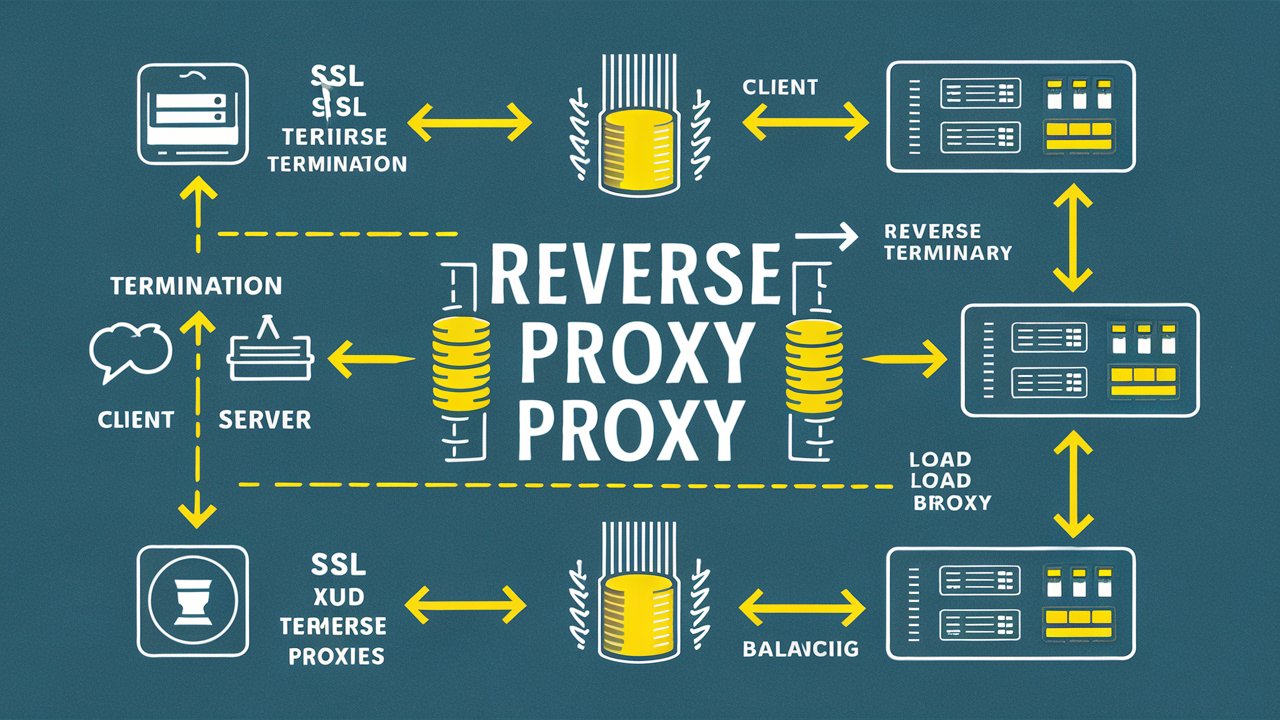How to Set Up a Reverse Proxy
 Aaditya Kediyal
Aaditya Kediyal
Setting up a reverse proxy is a powerful way to manage your web traffic. Whether you're aiming to distribute traffic, enhance security, or simplify maintenance, a reverse proxy can be a valuable addition to your network architecture. In this comprehensive guide, we'll walk you through the process of setting up a reverse proxy, covering the basics, advanced configurations, and practical code snippets to ensure you're well-equipped to implement this in your own environment.
Table of Contents
Introduction to Reverse Proxies
A reverse proxy acts as an intermediary for requests from clients seeking resources from servers. Unlike a forward proxy, which routes outbound traffic from a network to the internet, a reverse proxy handles incoming traffic, distributing it to one or more backend servers. This setup can provide several benefits, including load balancing, enhanced security, and simplified management of backend services.
Why Use a Reverse Proxy?
Reverse proxies are useful for several reasons:
Load Balancing: Distribute client requests across multiple servers to ensure no single server is overwhelmed.
Security: Protect backend servers from direct exposure to the internet, reducing the attack surface.
Caching: Cache content to reduce server load and speed up response times.
SSL Termination: Handle SSL encryption and decryption, offloading this work from backend servers.
Simplified Maintenance: Manage backend server updates and maintenance without affecting client access.
Choosing Your Reverse Proxy Software
There are several popular options for reverse proxy software, including:
Nginx: Known for its performance and low resource consumption.
Apache: Highly configurable and widely used in various environments.
HAProxy: Excellent for load balancing with extensive features.
Traefik: Designed for dynamic, container-based environments with built-in support for microservices.
In this guide, we'll focus on setting up Nginx and Apache as reverse proxies, as they are among the most popular choices.
Setting Up Nginx as a Reverse Proxy
Nginx is a powerful web server that can also act as a reverse proxy. It's renowned for its high performance and low resource usage. Let's start with the basic setup and then explore some advanced configurations.
Basic Configuration
Install Nginx
On Ubuntu/Debian:
sudo apt update sudo apt install nginxOn CentOS/RHEL:
sudo yum install epel-release sudo yum install nginxConfigure Nginx as a Reverse Proxy
Edit the Nginx configuration file:
sudo nano /etc/nginx/sites-available/defaultAdd the following configuration:
server { listen 80; server_name example.com; location / { proxy_pass http://backend_server_address; proxy_set_header Host $host; proxy_set_header X-Real-IP $remote_addr; proxy_set_header X-Forwarded-For $proxy_add_x_forwarded_for; proxy_set_header X-Forwarded-Proto $scheme; } }Replace
backend_server_addresswith the address of your backend server.Restart Nginx
sudo systemctl restart nginxYour Nginx server should now be acting as a reverse proxy.
Advanced Nginx Configuration
For more advanced configurations, such as load balancing, SSL termination, and caching, consider the following enhancements:
Load Balancing
upstream backend_servers { server backend1.example.com; server backend2.example.com; server backend3.example.com; } server { listen 80; server_name example.com; location / { proxy_pass http://backend_servers; proxy_set_header Host $host; proxy_set_header X-Real-IP $remote_addr; proxy_set_header X-Forwarded-For $proxy_add_x_forwarded_for; proxy_set_header X-Forwarded-Proto $scheme; } }SSL Termination
server { listen 443 ssl; server_name example.com; ssl_certificate /etc/nginx/ssl/example.com.crt; ssl_certificate_key /etc/nginx/ssl/example.com.key; location / { proxy_pass http://backend_server_address; proxy_set_header Host $host; proxy_set_header X-Real-IP $remote_addr; proxy_set_header X-Forwarded-For $proxy_add_x_forwarded_for; proxy_set_header X-Forwarded-Proto $scheme; } }Caching
proxy_cache_path /var/cache/nginx levels=1:2 keys_zone=my_cache:10m max_size=10g inactive=60m use_temp_path=off; server { listen 80; server_name example.com; location / { proxy_cache my_cache; proxy_pass http://backend_server_address; proxy_set_header Host $host; proxy_set_header X-Real-IP $remote_addr; proxy_set_header X-Forwarded-For $proxy_add_x_forwarded_for; proxy_set_header X-Forwarded-Proto $scheme; add_header X-Cache-Status $upstream_cache_status; } }
Setting Up Apache as a Reverse Proxy
Apache is another popular choice for setting up a reverse proxy, known for its flexibility and extensive module ecosystem. Let's walk through the basic and advanced configurations.
Basic Configuration
Install Apache
On Ubuntu/Debian:
sudo apt update sudo apt install apache2On CentOS/RHEL:
sudo yum install httpdEnable Required Modules
sudo a2enmod proxy sudo a2enmod proxy_http sudo a2enmod proxy_balancer sudo a2enmod lbmethod_byrequestsRestart Apache to apply the changes:
sudo systemctl restart apache2Configure Apache as a Reverse Proxy
Edit the default site configuration:
sudo nano /etc/apache2/sites-available/000-default.confAdd the following configuration:
<VirtualHost *:80> ServerName example.com ProxyPreserveHost On ProxyPass / http://backend_server_address/ ProxyPassReverse / http://backend_server_address/ </VirtualHost>Replace
backend_server_addresswith your backend server's address.Restart Apache
sudo systemctl restart apache2Your Apache server should now be functioning as a reverse proxy.
Advanced Apache Configuration
Advanced configurations for Apache include load balancing, SSL termination, and caching.
Load Balancing
<Proxy "balancer://mycluster"> BalancerMember http://backend1.example.com BalancerMember http://backend2.example.com BalancerMember http://backend3.example.com ProxySet lbmethod=byrequests </Proxy> <VirtualHost *:80> ServerName example.com ProxyPreserveHost On ProxyPass / balancer://mycluster/ ProxyPassReverse / balancer://mycluster/ </VirtualHost>SSL Termination
Enable SSL module:
sudo a2enmod sslEdit the default SSL site configuration:
sudo nano /etc/apache2/sites-available/default-ssl.confAdd the following configuration:
<VirtualHost *:443> ServerName example.com SSLEngine on SSLCertificateFile /etc/apache2/ssl/example.com.crt SSLCertificateKeyFile /etc/apache2/ssl/example.com.key ProxyPreserveHost On ProxyPass / http://backend_server_address/ ProxyPassReverse / http://backend_server_address/ </VirtualHost>Enable the SSL site:
sudo a2ensite default-ssl sudo systemctl reload apache2Caching
Enable cache modules:
sudo a2enmod cache sudo a
2enmod cache_disk sudo a2enmod headers
Add the following configuration:
```apache
<VirtualHost *:80>
ServerName example.com
CacheQuickHandler off
CacheLock on
CacheLockPath /tmp/mod_cache-lock
CacheIgnoreHeaders Set-Cookie
<Location />
CacheEnable disk
ProxyPass http://backend_server_address/
ProxyPassReverse http://backend_server_address/
Header add X-Cache-Status "%{CACHE_STATUS}e"
</Location>
</VirtualHost>
Restart Apache to apply changes:
sudo systemctl restart apache2
Securing Your Reverse Proxy
Security is paramount when configuring a reverse proxy. Here are some best practices to enhance security:
Use SSL/TLS: Encrypt traffic between clients and your reverse proxy using SSL/TLS.
Restrict Access: Use access control lists (ACLs) to limit access to backend servers.
Regular Updates: Keep your reverse proxy software and backend servers updated.
Monitor Logs: Regularly monitor logs for suspicious activity.
WAF: Consider using a Web Application Firewall (WAF) to protect against common web threats.
Monitoring and Maintenance
Regular monitoring and maintenance are crucial for the smooth operation of your reverse proxy. Here are some tools and practices:
Monitoring Tools: Use tools like Nagios, Zabbix, or Prometheus to monitor the health and performance of your reverse proxy.
Log Management: Implement centralized log management using ELK Stack (Elasticsearch, Logstash, Kibana) or Splunk.
Regular Backups: Regularly back up your configuration files and SSL certificates.
Performance Tuning: Periodically review and optimize your configuration for performance.
Conclusion
Setting up a reverse proxy can greatly enhance your web infrastructure by providing load balancing, security, and simplified management. Whether you choose Nginx or Apache, the key is to tailor the configuration to your specific needs and ensure robust security measures. With the guidance provided in this blog, you should be well on your way to implementing a reverse proxy in your environment.
Feel free to drop any questions or comments below. Happy configuring!
Subscribe to my newsletter
Read articles from Aaditya Kediyal directly inside your inbox. Subscribe to the newsletter, and don't miss out.
Written by

Aaditya Kediyal
Aaditya Kediyal
I am Developer from Delhi, India and my domain of expertise lies in Full-Stack Development . I am currently learning Devops and sharing my journey one day at a time. In future I'll be definitely moving to WEB 3.0 , Blockchain technology and Web RTC. Hopefully i will be contributing in future as well.